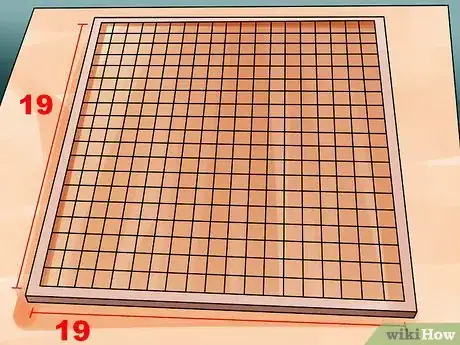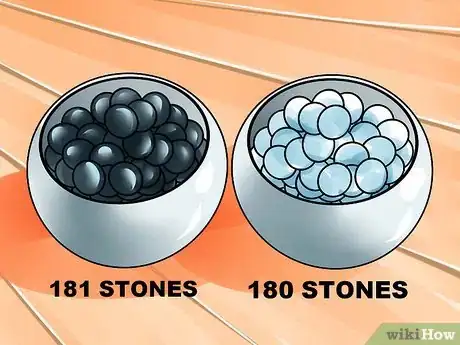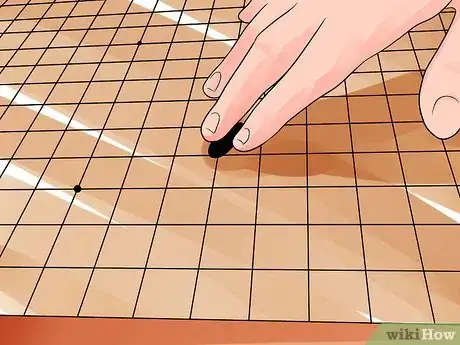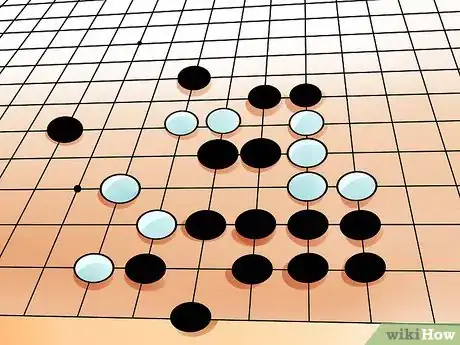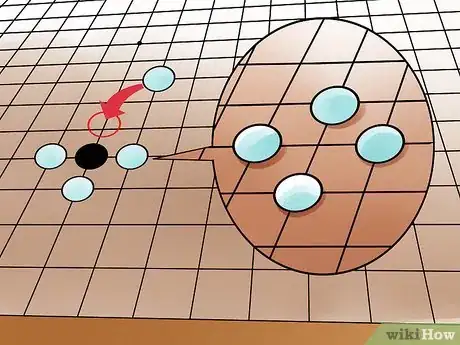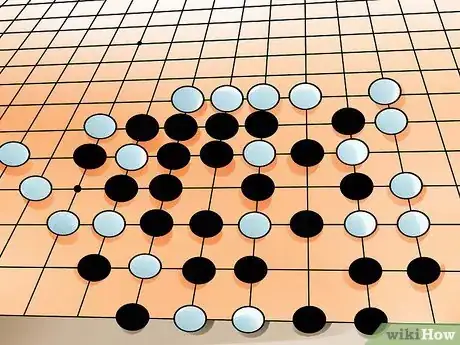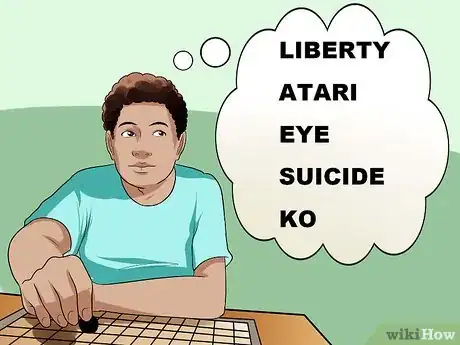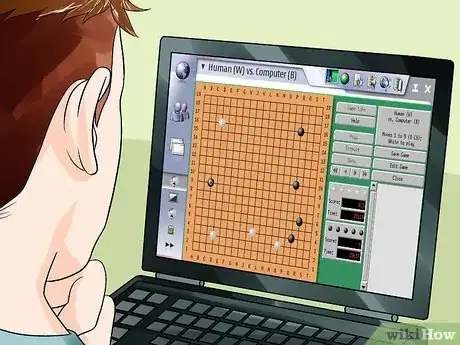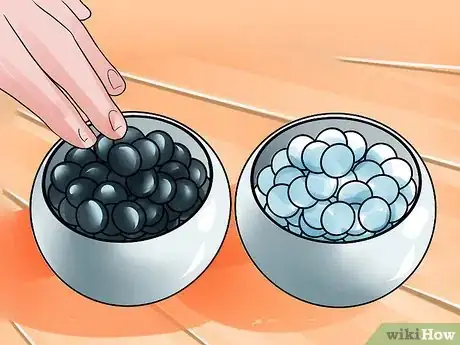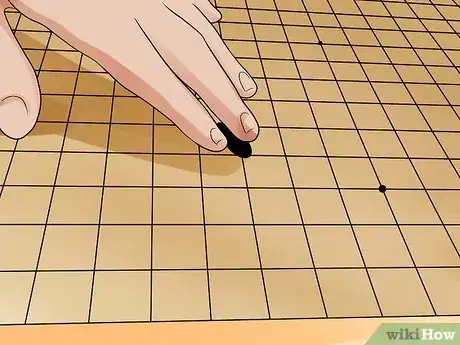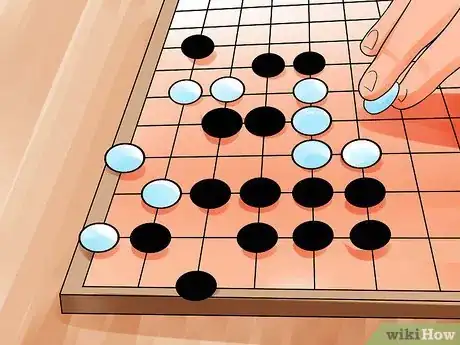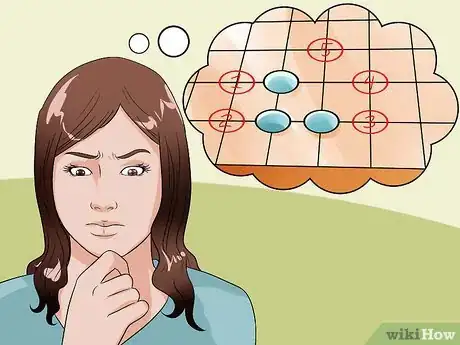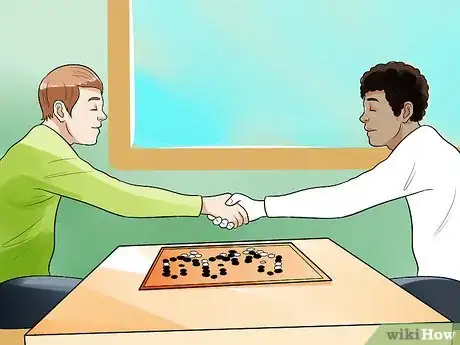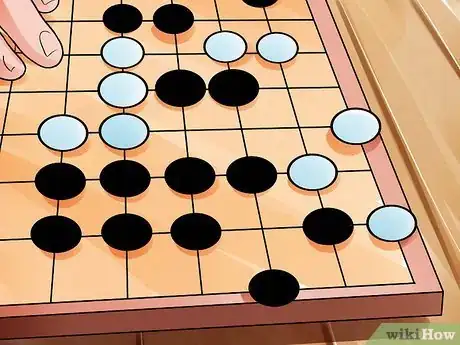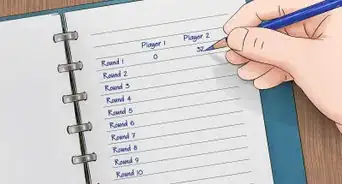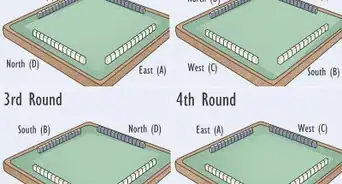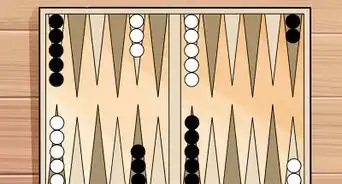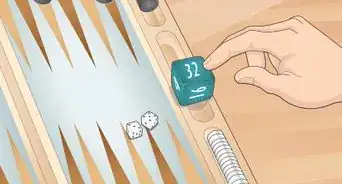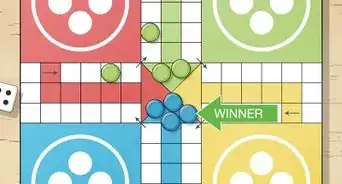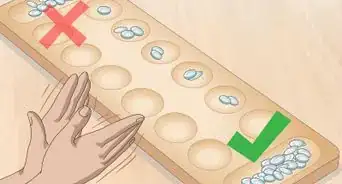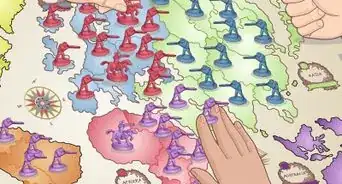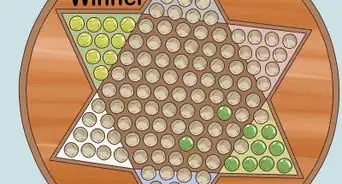wikiHow is a “wiki,” similar to Wikipedia, which means that many of our articles are co-written by multiple authors. To create this article, 50 people, some anonymous, worked to edit and improve it over time.
There are 7 references cited in this article, which can be found at the bottom of the page.
This article has been viewed 179,209 times.
Learn more...
Go is a game where two players contest for territory; it is perhaps the oldest board game in the world. The rules are simple and you can learn them in minutes. Many enthusiasts regard Go as an art; the game's almost infinite variations stumped even the most advanced computers until recently. Learning to play is easy, but learning to play well takes time and practice. Read along to familiarize yourself with this ancient, intriguing, and clever game.
Steps
The Board & Pieces
-
1Use a standard 19x19 grid. There are 19 horizontal and vertical lines. You can use a board or make a grid yourself.
- Sometimes smaller boards are used. Often 13x13 or 9x9 boards are used for quicker games or for teaching.
- There should be nine marked points spread out evenly on the board (4rd, 10th, and 16th lines). They are called "star points" and serve as reference points or markers for handicap games.
Fun Fact: In 2015, an automated system named AlphaGo learned to play Go, and it beat the human champion!
-
2Have 361 black and white stones ready. This amount is for a 19x19 game. The number correlates to the amount of intersections on the board. If you are playing on a smaller board, use fewer stones.
- Black plays with 181 stones and white with 180. This is because black makes the first move.
- Keep the stones next to the board, in bowls.
The Rules
-
1Alternate moves. Traditionally, black starts first.
- Stones can also be placed on the edge, where there is a T-intersection.
- Once a stone is placed, it cannot be moved (unless captured and removed).
-
2Acquire territory. This can be done in one of two ways:
- Territory is empty intersections that are bordered or surrounded by stones of the same color. Each empty intersection that is completely surrounded is worth one point, or moku. The bigger the territory you surround, the more points you gain.
- Corners can be used as a border as well.
- You will lose a point if you place a stone inside your own territory.
- Territory is empty intersections that are bordered or surrounded by stones of the same color. Each empty intersection that is completely surrounded is worth one point, or moku. The bigger the territory you surround, the more points you gain.
-
3Employ capturing. Connect your stones together to capture your opponent's pieces.
- Stones of the same color on immediately adjacent points are said to be connected, or joined. The connection can be horizontal or vertical, but not diagonal--the connection is along the lines.
- Fill all the adjacent points around your players pieces to capture them. Once captured, remove them from the board and keep them in a separate pile.
- No empty spaces can be within the border.
-
4Finish the game when all territory is claimed. Both players pass and the game is over. Count up how many points (or intersections) each color guards.
- Place all captured stones in the opposing players territory. Thus, their score is reduced due to lost intersections.
- Therefore, a captured stone is worth two points. One point negated from your opponent's score and one point for the new empty space surrounded upon removal.
- Capturing is what makes this game a battle of wits. While gaining territory is the main goal, one must think defensively at all times.
- Place all captured stones in the opposing players territory. Thus, their score is reduced due to lost intersections.
-
5Know your terms. As this is an ancient Chinese game adopted by the Japanese, there are many words to know.
- Liberty - an adjacent intersection
- Atari - a state in which a piece can be captured in the next move
- For example, "Your white stone over there is in Atari! Haha!"
- Eye - a single empty space inside a group
- If a single group has two eyes, capturing is not possible, as not all the empty space can be filled by the opponent.
- Suicide - placing a stone where it can be captured
- Ko - a situation in which a stone about to make a capture can be immediately recaptured, which would repeat the situation endlessly. Capturing cannot immediately take place after a ko.
- Sente - playing first, taking the advantage in a given position.
- Gote - playing second, responding to your opponent's move, giving up an advantage in a position.
Playing a Game
-
1Find an opponent. Someone who is well-versed in the game will be a better teacher and example.
- You can look for a game either face-to-face or on an online go-server. For face-to-face games, look for a local chapter of the AGA, BGA, or your national Go organization. You will likely find a list of Go clubs on their websites. For online games, some Go servers are listed below.
- IGS
- KGS
- OGS
- DGS
- Yahoo
- MSN Zone
- Go shrine
- 361points
- Break Base
-
2Start the game by choosing a color. In a handicap game, the stronger player takes white, and black places 2-9 handicap stones on the star points before white answers.
- For an even game, the colors are determined randomly. Since black has an advantage by playing first, white is compensated by taking komi, an amount of additional points added to white's score at the end of the game.
- The amount of komi varies, but most tournaments use values between 5 and 8 points. Sometimes a fractional value like 6.5 is used to avoid ties.
- Western go players most typically play by Japanese rules, where komi is set at 6.5.
-
3Place the first stone. This should be done by the player with black stones. It traditionally goes in the upper right hand quadrant.
- This initial move stakes out which side each player lays claim to.
- Handicap stones are considered the first move in a handicap game.
-
4Take turns alternating playing stones. Remember, the pieces are placed on the intersections of the grid, not the empty spaces on the board.
- Either player may pass if they see no benefit to making a move. Passing signals a desire to end the game and count the score.
- If both players pass, the game is over.
- Either player may pass if they see no benefit to making a move. Passing signals a desire to end the game and count the score.
-
5Decide on your strategy. There are generally two options: claiming the most territory or invading your opponent's territory by capturing their pieces (turning them into "prisoners").
- If a player places a stone that removes the last liberty from a connected group of the opponent's stones, then that group is dead and is removed from the board (captured).
- The exception to the above rule is that you cannot capture a single stone that just captured one of your stones without playing elsewhere first. This is called the rule of ko ("ko" means "eternity" in Japanese); it is needed to prevent games from never ending.
-
6End the game when both players pass. Black and white must both decide there is no advantage to laying another stone.
- The player who has captured the most stones and territory wins. Captured pieces should be placed on the board in the opponent's territory, decreasing their score.
-
7Score the game. You can use either area counting or territory counting. The two methods agree provided both players have made the same number of non-passing moves.
- For territory counting, most common in Japan and for most western go players, each color fills in their opponent's territory with any prisoners of that color captured earlier in the game. Their score is then only the empty intersections in their territory. White then adds their komi.
- For area counting, each color scores a point for each living stone of that color and each empty intersection within their territory. White then adds their komi.
- Both methods of scoring usually end up with the same result, but they may sometimes vary by a point.
Community Q&A
-
QuestionCan I play against myself?
 Channa231Community AnswerPlaying against yourself can be difficult, you have to think for two. However, you can set up a single board with already-placed stones and practice against a certain layout you've been struggling with. This can help you also learn new techniques against a certain play style.
Channa231Community AnswerPlaying against yourself can be difficult, you have to think for two. However, you can set up a single board with already-placed stones and practice against a certain layout you've been struggling with. This can help you also learn new techniques against a certain play style. -
QuestionWhat does a "living stone" mean?
 Community AnswerA living stone could be a monster or npc in your game that is made up of stones, or it could be a item to help your character regain life.
Community AnswerA living stone could be a monster or npc in your game that is made up of stones, or it could be a item to help your character regain life.
Warnings
- Be considerate to the other player, whether in person or on the internet.⧼thumbs_response⧽
- Online games are often played quickly, so watch your time.⧼thumbs_response⧽
- Although the rules of Go are often described as simple and natural, there are several different rule sets. Popular rule sets include Chinese, Japanese, New Zealand, AGA, and ING. Further complicating matters are game servers that claim to use one of the above rule sets, but don't program them correctly. For example, Yahoo is notorious for allowing a player who disputes the scoring to turn the game into no pass Go. Fortunately, the situations where it makes a significant difference almost always occur in artificial situations unlikely to occur (or to be recognized if they do occur) in natural games.⧼thumbs_response⧽
References
About This Article
Go is a fun 2-player board game where players compete to take over the most territory on the board. The board features a 19 by 19 grid. The game also comes with 181 black stones and 180 white stones. There is 1 more black stone than white stone because black always goes first. To play the game, black takes the first turn by placing a stone on one of the intersections on the board. Stones can be placed on any open 4-way intersection or any open T-shaped intersection at the edge of the board. After black takes their turn, white goes next. Play alternates back and forth throughout the game. The goal of the game is to acquire territory, which is done by surrounding empty intersections with stones of the same color. Each empty intersection that is surrounded is worth 1 point for the player whose stones surround it. Corners can be used as a border when surrounding empty intersections. A player can also capture their opponent’s stones by surrounding them with their own stones. If one or more stones are completely surrounded by the other player’s, those stones are removed from the board and set aside in the prisoner’s pile. The player who captured the stones adds all of the newly empty intersections to their territory. The game continues until all of the available territory has been claimed. At the end of the game, each player takes all of the stones they captured and places them in their opponent’s territory to reduce their number of empty intersections and points. Whoever has the most points wins the game! For tips on how to practice playing Go online, read on!
